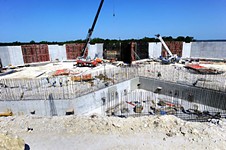Affordable Housing by the Numbers
Austin needs more housing to address homelessness
By Wells Dunbar, Fri., March 5, 2010
Homeless shelters like the Austin Resource Center for the Homeless and the Salvation Army come to mind when one thinks of shelter for those on the street, and not without reason: Emergency shelters like ARCH account for the lion's share of homeless capacity, with some 719 spaces. Transitional housing, for those positioned to rise out of homelessness, has a local capacity of 562. But permanent supportive housing units – intended for more than 18 months of residence, largely targeted to the chronically homeless, and the type recommended for the 1,900 units – amount to only 453, with 2010 funding for 46 new units. "We do have a significant gap in this part of the continuum," said Lurie. However, of the $11,152,000 in Health and Human Services funds available for homeless services, only about 10% – $1,103,000 – goes to long-term services, while most ($6,429,000) goes to short-term services like emergency shelters.
Permanent supportive housing is the battle cry of the nationwide "housing first" movement, because it would meet the immediate need of shelter before addressing the reasons underlying homelessness – if not simply persistent joblessness, then often domestic abuse, mental instability, or substance dependency. Speaking of permanent housing's success, Lurie cited some illuminating statistics: "More than 80 percent of individuals stay housed for at least one year. Incarceration rates are reduced for this population by 50 percent. Emergency room visits decreased by 57 percent. Emergency detoxification services reduced by 85 percent, and there's a 50 percent increase in earned income." The decline in ER visits, arrests, and the like – and the concurrent dip in costs to these institutions – is often touted as offsetting the costs of the program. "There's really no question that it is actually more expensive for us to leave people on the street," said Council Member Sheryl Cole. However, housing does cost. Margaret Shaw, director of Neighborhood Housing and Community Development, estimates the cost per unit at between $33,000 and $40,000, not including operating expenses.
The need for new permanent supportive housing – tallied for H&HS by the nonprofit Corporation for Supportive Housing – comes as the city debates how best to spend its remaining $13 million in bond money dedicated for affordable housing. Council is expected to allocate the funds at its March 11 meeting.
Got something to say on the subject? Send a letter to the editor.










